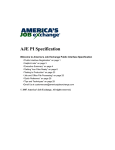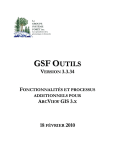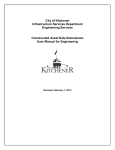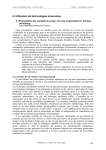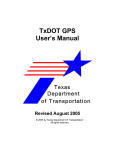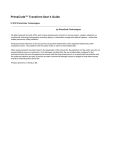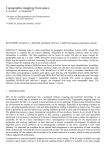Download User Manual for Multi Scale Mapping Specifications
Transcript
User Manual for Imagery and Elevation Acquisition Guidelines Version 1.2 NOTE: This document is to accompany the Imagery and Elevation Acquisition Guidelines of the same version number only! 1) Purpose a) Project specific overview information can and should be added to this portion. It is intended so as to provide the required background understanding of: i) who the purchaser(s) of the services is, ii) what they will use the data for, iii) when a similar project was last done, iv) what existing data (if any) can be provided for reuse or updating, v) known accuracy of any of the above existing data sets that can be provided for reuse vi) time frames that are acceptable for the data acquisition vii) expected schedules for the delivery of the data b) Any other information about the CA or its partners can be added as required 2) Horizontal Reference System (Datum), Map Projection and Vertical Datum a) The intent of this section is to ensure that the appropriate reference systems and projections are used. b) The default projection and datum are recommended as the base for all mapping in Ontario c) The actual UTM zone(s) required for the project should be included in this section. d) If the area straddles two UTM zones it needs to be determined if all the data has to be in both of the zones or only subsets of the data. As an example some of the data must be delivered in each of the two zones so as to meet the requirements of the various partners in the project. e) If some other projection or datum is required they can be added to or used to replace those listed. If this is done it would be prudent to also request the delivery in the base reference system and projection as per the Guidelines. 3) Data Accuracy a) Every participant in a given project could possibly have differing accuracy requirements. Even with a single participant there is likely to be some areas requiring higher accuracy data than other areas. Typically less accuracy is required in more rural areas than in urban areas. b) It is important to clearly determine the required accuracy and resolution of image data for each area to be mapped. This should be based on an understanding of the User Requirements balanced by the expected costs of different levels of accuracy. c) The Guidelines specify four accuracy levels. Not all projects will require all four levels. Some may only require one, two, or three of these levels. Choose the ones you need. d) It is recognised that Level 1 is a very expensive option that currently may be neither necessary nor affordable. At some point in the future the cost of this level will be significantly lower and thus justifiable. It may also be required currently for specific small areas of high risk or as an example in preparation for redevelopment or redesign of stream channels. e) It is recognised that Level 4 is a very coarse option that may not meet the business requirements of most CA's. For some rural CA's this may be all that is affordable and thus justifiable. Consistent reliable Level 4 data is better than data of unknown quality or reliability. f) The goal should be to choose the level of accuracy that meets the specific partners business needs. g) It is best to define a shape file of the area(s) that are required for each data accuracy level and provide these to firms or agencies that may be doing the work. If it is an RFP then these shapefiles should be included with the RFP source materials so that vendors can plan the acquisition and production phases accordingly. This will help to minimise your data acquisition costs. h) It is important to define which deliverables the accuracy specs apply to. The intent is that these specs refer to the accuracy of the final products that are delivered and ingested into your GIS. Examples are: i) A level two elevation data set would mean that an elevation derived for an arbitrary horizontal location from the elevation data set, most commonly from a TIN made up of the mass points and break lines, would be accurate to 0.25 m at the 90% confidence limit. This also applies to any Lidar based data sets. ii) Planimetric features collected to a level two spec would be expected to represent the features with the same accuracy of 0.25m at a 90% confidence level iii) A level two ortho would mean that 90% of the features that can be identified in the imagery will be accurate to 0.25 m at a 90% confidence level. i) It is possible that you may require different features collected at different specifications within a single area. An example may be that you wish to have ortho imagery accurate to 0.25m but only require DTM data accurate to 1.0m. Defining this clearly in the RFP can allow you to save money. 4) Ground Control a) b) c) d) e) f) g) h) i) j) New survey control is expensive. It can range widely in price due to factors such as quantity, accessibility, distance from the surveyors office, required accuracy level, monumentation requirements, etc. Ideally there will be a minimum of about 30 surveyed and targeted ground control points for any project. The reason for this number is to allow for a statistically significant number of points that can be used to quantify the accuracy of the other data products. The total number of required control points may be much higher for large projects or projects with very high accuracy requirements or lower for small projects or projects with lower accuracy requirements, i.e. level 3 or 4. The higher the required accuracy level of the data the greater the need of ground control points to ensure the accuracy will be met. As an example a project covering all four accuracy levels (12.5, 25, 50, and 100 cm) may need a control point every 1, 10, 50, 200 sq km respectively. These numbers are meant as an example only as there are no hard rules as to the number of required points to control aerial photography or lidar missions. Every operator will work within their own different guidelines based on their equipment and procedures. If some of the funding parties involved require it then it may be desirable to require the placement of permanent or semi-permanent monuments so that they can be recovered and reused for other applications. Otherwise there is no need for such permanent monuments to be established for the mapping projects themselves. All that is really required is photo identifiable points with a known accuracy that can be measured during the AT or Lidar process. Existing imagery of a lesser accuracy than the spec for the new imagery should not be used to control the new imagery. This is because if the control source is less accurate than the required mapping spec it will be nearly impossible to achieve that spec with any degree of reliability. Ideally the control points will be at a higher accuracy spec than the final mapping spec for the area. This could be in the range of 1/10th to 1/3rd of the final spec. This is typically only practical with projects where surveyed control is to be used. The use of existing data sources for control can partially or completely remove the need for new survey work and thus its costs. Examples would be previous ortho projects that had targeted or photo identifiable control points that are at a comparable or smaller GSD than the new project. In this case the control point locations can be carefully transferred to the new imagery with very little loss of accuracy. The actual surveyed coordinate values would be used as the input to the imagery orientations. In the case of transferring control from old data sources it is important to get copies of the source image chips used to derive this control. This is for several purposes. First is for subsequent reuse of the data. Another is to use this older data as an input for quality control on subsequent project. Having the requested sketches, diagrams, and details about all control used allows the CA to reuse this data in future projects and not have to pay for it again. k) Reusing control points also allows the CA to see if there have been significant shifts in the ground when a new adjustment is completed. This would be evident if the new AT adjustment showed significantly different results than the source survey information. l) You should expect the group doing the new work to use their best judgement in determining if an old point is still sufficiently unaltered on the ground to allow it to be reused. If there are subsequent problems with the control data this may be one area to double check as a source of problems. m) There was some disagreement among the committee working on these specs about the amount and type of control that should be stipulated in a RFP. As stated previously there are no hard and fast rules as to how many control points are required for a given area. Variables that can affect this include: i) GSD ii) Image quality iii) ABGPS quality iv) IMU quality v) Image sensor geometry vi) Image overlaps vii) Map area shape or configuration viii) Control point configuration or layout relative the image block ix) Aerial triangulation software and procedures employed n) Having "enough" control should be the requirement. The only real proof of if there is enough control for a given project is if the resulting products, i.e. the DTM, Orthos, and other derived products meet their respective data accuracy requirements. 5) Imagery a) The expectation is that most projects will be based on digital imagery in the future. Digital cameras are not necessary for all applications. Leaving the option to the vendors to propose the use of a film camera option may result in significant cost savings and more competitive bids or more timely acquisition of the imagery. This choice will have to be made on a case by case basis. b) It is expected that the user will define which of the data types (Panchromatic, Natural Colour (RGB), or colour Infrared (CIR) are required for each project and or area within a larger project. It may not be necessary to get CIR for all projects and it does add a little to the project cost. It is generally a good idea to get the raw optical imagery including the Panchromatic as well as the Multi-spectral (RGB) data. While there may not be a direct application for the panchromatic data at the time of the project it can be beneficial to have available in the future. Where budgets will allow it the same argument can be made for at least gathering the raw infra-red dead in addition to the natural colour data. It can always be used as a reference at a later date if required. c) Digital cameras (Intergraph, Vexcel, Leica, etc) all use the manufacturers proprietary software to convert the as acquired imagery to a usable form such as Geotiff. As such they have limited amount of control over how that conversion takes place. This is part of why the guidelines do not try to specify too much detail about this portion of the process. It is sensor hardware and software specific. d) The software to do pan sharpening of the multi-spectral digital camera imagery used in current digital frame cameras from companies such as Vexcel and Intergraph is also proprietary and manufacturer specific. As such the flight firms essentially pass the data through a black box with the intent of getting the best image quality they can with the tools they have. e) Having the source imagery available in Geotiff format will allow vendors on subsequent contracts to reuse it for derivation of control. It will also allow you to provide this data, along with the image orientation information, to all vendors to provide other mapping services such as planimetric data collection. It may also eventually be used for automated change detection although at this point in time such software is very limited in its utility for large scale projects such as these. f) The imagery overlaps are stated as minimum values. The forward overlap is the overlap between frames along a flight line. This must be greater than 50% in order to allow stereo coverage. The normal range for this is in the 55-65% range. Increasing the forward overlap to 70% or 80% will g) h) i) j) k) l) m) help to reduce the amount of apparent radial displacement in the imagery. This is what causes buildings and trees to appear to lean away from the centre of the image. However increased forward overlaps can result in reduced vertical measurement accuracy. This is because the vertical accuracy is proportional to the ratio of the distance between frames and the height of those frames above the ground. The lateral overlap refers to the overlap between the flight lines. This is usually in the range of 20-30%. The lower this number is, the lower the flying costs will be. However too low a number can result in potential unintended stereo gaps between flight line due to problems such as in air turbulence or being off the planned photo positions. Increasing the lateral overlaps will also help to reduce the apparent lean of features such as buildings and trees but also at the penalty of an increase in the cost. Another approach to reducing building lean is to get "spot" photos. These are single frames taken over key structures such as large public buildings or bridges. As the photo is centred directly over the structure the radial displacement in the image is negligible. This approach is especially useful in smaller communities where there are not large areas of very tall structures. As discussed above in some situations it may be desirable to increase the amount of overlap. Some examples of this include i) Dense urban areas with very tall buildings creating urban canyons. These areas could significantly benefit from the use of as much as 80% forward and 60 to 80% lateral overlaps so as to minimise the amount of the street that is obscured by the radial displacement of buildings in the imagery ii) Forest vegetation studies where apparent tree lean is undesirable iii) For use with proprietary Digital Surface Model auto correlation software that relies on multiple overlaps to improve the ability to extract bare ground features from the DSM (1) It should be noted that as stated before the use of greater forward overlaps reduces the potential vertical accuracy that can be achieved from the stereo model. This is due to a reduction in the base to height ratio which weakens the geometry of the model. To overcome this reduction in vertical accuracy, many multiple elevations need to be correlated for each point and the best fit taken to these varying results. It should be noted that most current digital cameras cannot take more than about one photo every one to two seconds. This is not normally a problem except if the requirement is for high forward overlaps such as 70 or 80% with very small pixels such as 5 to 10 cm. There are ways to overcome this limitation and newer sensors will likely remove this as a problem in the near future. It is inevitable that the aircraft will not be able to achieve the exact planned location for each image. This is not necessarily a failing on the part of the pilot. Rather it is simply the reality of the business. This is why there needs to be an allowance for slight variations from the plan. The numbers included in the guidelines are conservative and can be relaxed somewhat if necessary without jeopardising the quality of the end product. Any relaxation of the spec should only be for a small subset of the data except in exceptional circumstances. The listed GSD's for the various project levels are only suggestions. Individual contracts may require significant changes to these numbers to meet individual users requirements. Note that a 2X improvement in GSD typically results in a 3-4X increase in the costs. The reverse is also true, coarser GSDs cost less. The same can be said about the relative costs of improving the quality of a DTM. The base requirement is for all the imagery to be free of things such as cloud, smoke, dust, haze, snow, ice in water bodies, leaves, etc. It is recognised that specific projects may encounter situations where this is not 100% possible. This can be a result of poor weather during the acquisition window or due to insufficient acquisition resources being available at the right times. In such situations the CA's Project Manager can elect to waive or reformulate these criteria as is appropriate in conjunction with the acquisition firms. The decision as to whether this project is to be leaf off or leaf on is a basic one that needs to be made at the outset. If it is to be leaf off it needs to be recognised that this puts it into the busiest acquisition period for most firms. As a result the imagery will be more difficult to obtain, more expensive, and come with increased risk that it will not all be obtained. If other constraints are added, such as snow and ice free, the potential window of opportunity is reduced even more and likelihood of success diminishes accordingly. n) The higher the sun angle, the less noticeable the shadows will be in the resulting imagery. The minimum sun angle should be selected as either 30 or 35 degrees. The smaller number is better for leaf off projects so as to allow for a longer flight window in the early spring and late fall. Summer flights can easily be restricted to 35 degrees with little effect. o) Having the sun too high in the sky is also a problem as it can cause a "hot spot" within every frame. This results in a small portion of the frame when the sun, the plane, and the ground are all nearly in a line. This results in an area with essentially no visible shadows. This means there is very little contrast and the area typically appears to be very bright and low contrast. It is very difficult to make such areas look "normal" in a final ortho. As a result it should be avoided. The actual sun angle at which this can occur varies with different sensors geometry and with the slope of the terrain. p) The included pan sharpening spec is specifically designed to include the Intergraph DMC digital sensor. There are better and worse sensors available. However the DMC can produce high quality imagery when used appropriately. At the time of this writing there are less than 10 large format digital sensors in Canada. These include 4 Leica line scanners (no sharpening), 3 Vexcel frame cameras (2:1 pan sharpening ratio), and 2 Intergraph frame cameras (5:1 pan sharpening ratio). q) Saturated pixels are areas of pixels with all 255 values. Such areas show no tonal separation and thus no detail. These are to be avoided as much as possible. However they cannot be completely avoided and they generally cannot be corrected with post processing. They are usually caused by specular reflections off features such as waves, car windows, metal roofs, snow, sand. So long as the area affected is small it should not be a major problem. r) All current large format based frame cameras create their high resolution frames by merging together the data from multiple CCD's. This is all done in proprietary software and is normally not noticeable. If it is noticeable it can often be fixed by either reprocessing the raw data or by touching up either the raw image or the final orthos in software. s) Image compression is often used at various stages in the production process. Most sensors use image compression at the acquisition stage in order to speed the data transfers. Many production shops use compression for the same reasons. It is important to keep the amount of compression to a low value (i.e. ±≤10:1 for color and ±≤ 5:1 for panchromatic). If this is done and the data is not repeatedly recompressed, i.e. at different production stages, the final orthos will not show significant image degradation. t) There are several reasons for acquiring the imagery with a smaller GSD than the final orthos. The main ones include leaving enough leeway for the variations in actual versus planned flying heights, variations in terrain elevation, variation in sensor orientation due to turbulence, and degradation of the image detail during ortho re-sampling. It is also true that a product at a given final ortho GSD will look better if it came from a finer source than if the reverse is true. 6) Image Orientation Information a) The intent of the Image Orientation section is to ensure that all required deliverables are received to allow complete access to the information required for other products to be derived from the raw imagery. It is also so it can be used in support of updated data products via a new imagery acquisition project in the future. b) A result of the above will be that all vendors will be able to bid based on a level playing field in the future by being able, where appropriate, to reuse existing data sets to their fullest c) The AT report must include the following topics i) Name of firm completing the AT work ii) Name of firm completing the image acquisition iii) Sensor brand and model names, iv) nominal images scales, v) nominal GSD vi) lens focal lengths, vii) camera calibration reports, viii) flying heights used in the data acquisition ix) Software used to collect and process the raw image data x) Software used to complete the bundle adjustment xi) Results of the bundle adjustment including as a minimum: (1) RMSE on photogrammetric (pass and tie) points (2) RMSE on control points separated by control classes (ie. Targeted, photo ID, existing map, existing ortho, etc) (3) Statement as to the expected map accuracy of products derived from this set of image orientations xii) Statement of compliance with the accuracy specification d) The intent of the deliverables is to provide the information required to import the orientations into virtually any photogrammetric software package and allow high accuracy and parallax free stereo model viewing e) The shapefile is intended for ease of use of the data. It is not intended that it would capture all the information in the sketches and other documents. 7) Elevation Data Capture a) b) c) d) e) f) g) h) i) j) k) l) All data is to be delivered in full 3D mode. This means that a shapefile would contain PointZ, PolylineZ, and PolygonZ data sets with the Z values of the individual points that make up the lines being non-zero. This is to ensure that the data can be used in as wide a variety of surface modelling applications as possible. For an AutoCAD file this would be a full 3D file with elevations for every vertex, not a 2 1/2 D mode as is sometimes used. Similarly for Microstation DGN files all data is to be full 3D. A Shapefile attribute of "elevation" or "Z" can be added to datasets after the fact if that is determined to be a requirement. This could be done as part of the mapping contract or separately by the CA in a batch. Feature layers can be added to or removed from the list as required. The list provided is what was determined to be the minimum required to meet CA's normal business requirements. Individual CA's and their constituent municipalities may well require significantly more feature layers than this list contains. Each feature layer should have the accuracy levels required for it stated correctly in the table. That is if the CA only needs buildings to be at level 2 accuracy, it would be wise to remove the levels 1,3 and 4 ones from the table so as to avoid confusion during the RFP process. Elevation data is the single most valuable tool for Flood Plain modelling. Having all the required data in the correct format and structured to allow for its application with stream modelling software will save a lot of time and money for the CA's Breaklines are also required with most Lidar data sets in order to properly constrain the surface at the breaks. These breaklines can be derived from the Lidar data itself with specialised software under operator control or from standard optical imagery with photogrammetric techniques. In both cases the quantity, location, and individual vertex accuracy of the breaklines has a significant impact on the resulting surface model. By specifying the feature levels in the minimum list should give the CA a high quality DTM for hydraulic modelling purposes. If the CA wishes they can generate their own TIN's and contours. However it is advised that the vendor of the data use a TIN to test their data prior to delivering it to the CA. The QA process should also use a tin from the delivered DTM for checking for accuracy. If desired the contours could be converted to a 2D Line shapefile instead of a 3D LineZ shapefile if each contour is given an elevation attribute for use within the CA's GIS. However it is key to still receive the full 3D version of the data to allow it to be fully reused in the future for update work. Contours should be produced with intermediate contours being every fifth contour. That is if the project calls for a 0.5 m contour interval the intermediate contour would be at 0.5, 1.0, 1.5, 2.0, etc and the index contours would be at 2.5, 5.0, 7.5, etc. Contours should not be made at an interval that is less than at least two times the LMAS of the input raw point and breakline data. Otherwise users may mistakenly attribute greater accuracy to the contours than they actually have. It should be noted that there is a major difference between a DTM that was collected as discrete elevations on a regular grid and supplemented with breaklines and a gridded DEM generated m) n) o) p) through interpolation from a TIN made from a sparser set of mass points and breaklines. Given the same raster spacing the former should be more accurate and detailed than the latter. Beware of receiving DEM's in a raster format without also getting the breaklines and other elevation data (Lidar or photogrammetric) from which it was interpolated. More data is not better data! There is no value in terms of accuracy of the surface model in interpolating a grid at a 1 m posting from a TIN formed from data with an average posting of 10 or 20 m. The most important aspect of a DTM is the ability to extract an elevation from it at any horizontal location and have it meet a ground truth test within the LMAS specification for its area. DTM Data Density i) The required density of the data is a difficult thing to define precisely for all types of terrain and accuracy requirements. Smoother terrain requires fewer data points or breaklines to accurately define the surface than rough terrain. Terrain does not have to be steep or mountainous to need a higher density of data. Surface roughness is the key criteria. ii) Lidar normally generates data sets with a high point density. These can range from a point every few square meters to many points per square meter. Choosing a point density that provides sufficient detail is the goal. Except with very high (greater than 4 points per square meter) it is usually advisable to supplement the data with break lines. iii) Photogrammetrists have typically taken the opposite approach to Lidar to collecting data. Instead of a very high density of random points the operators are instructed to pick up the key features. Thus top and bottom of bank, high points, low points, etc are required. This approach results in a smaller initial data set as compared to Lidar. iv) Digital cameras offer greater success with auto correlation of elevations. This entails using software to correlate image pairs to find the elevations, typically in a grid layout. The advantage of this approach is that it is highly automated and relatively inexpensive. Most software packages are reasonably successful at creating elevation points wit a spacing in the range of 5 to 20X the GSD of the imagery. These data sets usually require high levels of editing, as with Lidar, in order to remove above ground features such as trees, buildings, cars, etc. v) The determination of what the data density must be should be left to the data providers to determine. The key factor is that their data should be rigorously tested to ensure compliance. Unless you test the data you will not know how good it is! In that case it doesn't matter how dense it is. Dense data can be less accurate and less usable than a significantly sparser data set! Updating of Existing GIS Layers i) This section is only intended to be used if the CA has an existing data layer that it feels: (1) Meets the accuracy requirements of the new project (2) Meets the data content requirements of the new project ii) If there are not layers that can be reasonably updated this whole section should be removed from the document. iii) Existing data that does not meet the above criteria should not be updated, but rather replaced with an all new data set based on the new imagery layers iv) Providing as much information as possible about where there have been, and equally important, where there have not been any changes will help to minimise the cost of doing an update. Information such as a GIS layer with all building and construction permits, known areas of high lakeshore erosion or stream bank changes, since the last data acquisition will assist the contractor in determining where to concentrate their efforts. v) The intent of adding the "deleted", "added", and "modified" tags to the "status" attribute is to allow for the maintenance of a temporal aspect to the GIS. This will allow future users to query what was in a certain location at a previous time. As an example this could be useful in situations where there may be residual toxicity from a building that was previously used for storing chemicals. This is intended to become a kind of GIS "memory" for future users. If desired this option can be removed from the spec and replaced by having access to the older data sets in separate layers vi) If the contractor finds old features that: (a) do not appear to have been changed (b) appear to be in a different location (c) or of a different shape from what was originally put into the data layer (2) then the CA needs to work with the contractor to determine the best way to proceed (3) this could possibly mean adjusting the contract value accordingly or changing the scope of work to stay within the budget (4) The options can include: (a) No change to the old features even though they are out of spec. This is the lowest cost approach but obviously leaves the data base with data now known to be inaccurate. However if the metadata clearly shows this reduced accuracy level then at least it can be kept in mind when decisions are made that could be affected by it. This is not recommended. (b) Replace the features with new ones meeting the spec. This will result in the improvement in the data base quality but throws a lot of unknown costs onto the contractor which they may be unwilling to assume without appropriate compensation. This however is the best approach in terms of data quality and reliability. (c) A third option of trying to adjust or modify the old data on a feature by feature basis to fit the new imagery. This is generally the most expensive option and can still leave the resulting database in a compromised situation. The reason for this is the difficulty in finding all the "small" areas of change and ensuring that they are all caught and fixed. If there is any significant amount of bad data to correct then this is an inefficient way to fix it. We strongly recommend against using this approach to updating data. It can often take substantially longer to fix bad data than to simply recollect it from scratch. q) 8) Lidar Acquisitions a) The point spacing of the Lidar data is something that will vary depending on the planned use for the data. The included table is meant as a guideline only. b) It is not necessary to include specs for areas of accuracy Levels not to be covered by the Lidar data. This would be the case if only a subset of the project areas are to be covered by Lidar and the remainder by some other means. c) The ground cover classes included are meant as suggestions. If other ground cover classes are dominant in your region or of greater interest then they can and should be used to replace the ones in the spec. d) Lidar collection and processing equipment is constantly increasing in its ability to generate more accurate readings, higher numbers of points per square meter, and to filter them more efficiently. These specs should be revisited by a Lidar expert every few years to ensure they are up to date. e) Lidar DTM data sets will show less regular point spacing in heavily vegetated or treed areas as fewer points will make it through the vegetative cover to the ground. This is to be expected. This can be compensated for by keeping the scan angles narrower, increasing the pulse rates, and/or doing multiple passes over the same areas. The individual firms will need to determine which approach is the best for their specific sensors and procedures. f) 9) Orthophoto a) While large area projects may be planned to require full image and DTM for every tile (i.e. where the project boundary and the tile boundaries coincide), it is reasonable for a portion of the edge tiles required along the project boundary to be left without data. In these cases a black or white fill helps to differentiate these areas. In this case keeping all other image data away from the fill colour (either 0,0,0 or 255,255,255) will enable the fill colour to be made transparent in most GIS viewing packages b) It is recommended that the JPEG2000 standard be used for all orthophoto image deliveries. This standard is supported by most major GIS and CAD software packages. It has the advantage of not incurring any extra costs onto the data producers which saves the CA's money. c) d) e) f) g) h) i) j) k) l) If required by project participants any of ECW, MrSID, or JPEG2000 can be used. For all practical purposes they can be considered roughly equivalent from a quality and size perspective The suggested maximum compression ratio for colour imagery of 20:1 for individual tiles can be changed to suit specific projects. Note that using compression ratios higher than 20:1 can result in a potentially significant reduction in image quality and thus the utility of the data set. The suggested maximum compression ratio of 50:1 for overall image mosaics can be changed to suit specific projects. Note that it may be desirable to also reduce the pixel size by a factor of 2, 4, or some other value (ie. Go from 10 cm to either 20cm or 40 cm …) to get further reductions in the final file size. Combining reduced resolution data sets with increased compression can result in even higher overall file size reductions and thus reduced display times over the web or intranet. Note that a 20cm file is 1/4 the file size as that for a 10 cm file covering the same area (ie. 100 Mb versus 400Mb). If a digital camera is being used then having the data delivered in 16 bit per band or 48 bit for RGB files will ensure the best quality data is available to the CA. Having a deliverable of a shapefile showing the exact location of the mosaic seam lines will allow the CA or its QA contractor to quickly confirm the quality of the radiometric balancing and mosaicing of the data. From a cost perspective it may or may not be desirable to require the 16 bit panchromatic data be rectified. Each additional ortho deliverable on top of the RGB does add to the cost. Having the price for this and other products broken out allows the CA to make choices based on data utility and cost. The Image Quality criteria can be varied if required. A common occurrence that can be costly if not impossible to remedy is specular reflections from water, glass, steel, etc resulting in saturated pixels. So long as these do not negatively affect the users ability to identify features it is more cost effective to ignore them. m) 10) Quality Control a) It is assumed that the agency or firm producing the data will have their own in house QC procedures. The QC plan in PDF is meant to document this plan and explain it b) Having a plan is not a guarantee that it is fully or even partially implemented. This is in part why the focus of the specification is on the outcomes, that is on the resulting data sets and not on the processes. c) 11) Quality Assurance a) Some level of QA should be carried out by the CA on all projects! b) Without carrying out a detailed QA there is no way of determining if the data is meeting the specification or not. c) It may be desirable to contract the QA work out to a separate firm. This can help to ensure that the resources are available to carry out the work in a timely manner. A target of 5-10% of the main contract value should suffice for a typical QA contract. d) The extent or amount of QA done in terms of sampling rates will depend on a number of factors including: i) Resources available to do the QA ii) Level of confidence in the data provider(s) iii) Accuracy level required of the data iv) Time available to check the data before making use of it e) It is recommended that some basic data integrity software checks be created to automatically look at all data sets for compliance with file formats, attribute population, coverage, etc f) It is recommended that all supplied ortho imagery be viewed at a small scale on screen in order to confirm: i) Completeness of coverage ii) Colour balance is appropriate for the land cover iii) Seamlessnes of radiometric balancing between frames, flight lines, different dates of acquisition iv) General horizontal accuracy via viewing that the features that cross over tile boundaries align on either side of the tile edges g) It is recommended that a subset of the data be tested intensively. An often useful plan would be to: i) First check a small number (25 to 50) of data sets in their entirety. These tests should include (1) Completeness of data capture via comparison of the features with the ortho imagery (2) Accuracy of features in aligning with the ortho imagery (3) Accuracy of the data in comparison to other data sets of similar or better accuracy (4) Complete and accurate populating of all features attributes (5) Topological aspects should be visually tested but it would be better to use automated routines to identify topological errors in the data ii) If in this first test a high percentage (> 5% ??)of non-compliant data was discovered then the data provider should be notified and all data rejected until the provider can reprocess all data and confirm that the data will subsequently pass the tests. A second data set separate from this first one should subsequently be submitted to this rigorous testing to ensure that the corrections are carried out on data other than the previously rejected ones. iii) If a small percentage (< 5% ??) of non-compliant data was discovered then the data provider should be notified and the tested data rejected. The QA would then resort to a 2-3% sampling rate of rigorous testing. iv) If all data are found to be compliant with the specs then the QA might reduce its sampling rate for rigorous testing to a 1% rate. v) The above sampling rates are suggestions and can be varied as the CA feels is appropriate a) 12) Metadata a) The intent of the metadata spec is to capture all the pertinent information about each data layer b) GOITS has been selected as the one mandated by the Province. Other specs such as the FGDC can be used if preferred as it is the most common spec currently in use c) Metadata is only required at the project level for each data set type. That is a single metadata file and accompanying shapefile for each of: Orthophotos, DTM's, AT, Lidar, Aerial Photography, etc. d) Providing to the vendor producing the final products a template XML with the appropriate contact information filled out will expedite the process and ensure that metadata accurately represents the CA's requirements. e) 13) Deliverables a) b) c) d) e) f) Deliverable formats can be changed based on the users internal requirements The list has some optional items that can be removed from a given project if not needed The intent is to keep the formats that are used by the majority of the GIS community Requiring full 3D data layers ensures the future utility of the map data Requiring stereo imagery and orientation allows the imagery to be reused as a source of information for future contracts and allows ad hoc data requests to be fulfilled by in house or contract firms. This should be considered a key deliverable The choice of delivery media is open to change to meet the CA's requirements 14) Copyright and Licensing a) The goal is to ensure that the CA and its cooperating agencies all have free and unfettered use of all data layers in perpetuity. b) It is also important that all products be licensed to the CA so that they can provide them to any existing or future contractors who may wish to use them for future projects including updates of the current project and value added feature projects from the current project. 15) Appendices a) Appendix A i) This table shows the relationship between some common ways of looking at accuracy ii) The actual accuracy tests carried out in the QA portion of the work should report in CMAS and LMAS terms iii) All these statistics assume that the data has a Gaussian, or Bell curve, distribution. If this is not the case then more investigation on the part of the QA contractor and ultimately on the part of the data vendor may be required.














